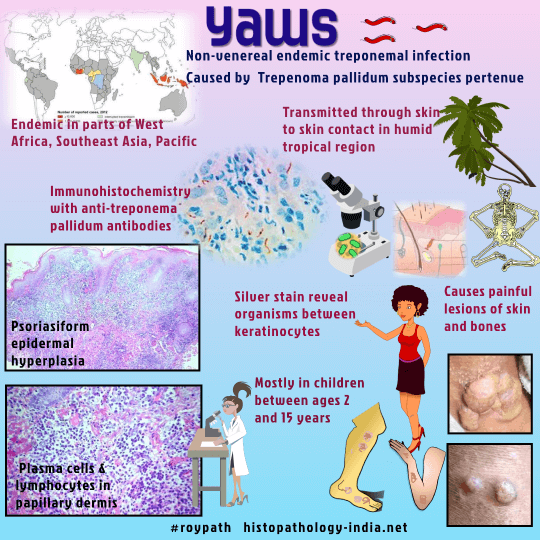|

Custom Search
|
|
Infectious Disease Online Pathology of Yaws
|

|
Yaws is a systemic treponematosis caused by Treponema pertenue, a spirochete that is morphologically and serologically indistinguishable from Treponema pallidum. Like syphilis, yaws has three stages and a period of latency, but it is non-venereal and late lesions are limited to bone and skin. Treponema pertenue does not cause late lesions of the cardiovascular system, the central nervous system, or other deep organs. Children and adolescents living in deprived tropical regions are at risk. Transmission is by skin to skin contact and is facilitated by a break or abrasion. Two to five weeks after inoculation, a single "mother yaw" appears at the site of inoculation, usually on an exposed part. It begins as a papule and becomes a "raspberry-like" papilloma, 2 to 5 cm across. The disseminated or secondary stage begins with the eruption of a similar, but smaller, raspberry-like lesion on other parts of the skin. Microscopically the mother lesion and the disseminated lesions resemble each other. There is hyperkeratosis with a finely lobulated contour, papillary acanthosis, with elongation and pointing to the tips of the rete ridges and an intense infiltrate of the epidermis by neutrophils. The epidermis dissolves at the apex of the papilloma , where neutrophils are concentrated, to form a shallow erosion of the surface. The dermal papillae are hyperemic and edematous. Plasma cells invade the upper dermis. Spirochetes are numerous in the dermal papillae, particularly in foci of neutrophils and in superficial exudates. Unlike the causative organism of syphilis, Treponema pertenue does not invade, compromise, or destroy vessels. Painful papillomas on the soles, lead the patient to walk on the sides of his feet like a crab, a condition called crab yaws. Shortly after inoculation the treponemes are borne by blood to bone, lymph nodes, and skin. Here they grow during a latent period of 5 or more years. This is followed by lesions of the late stage, which include gummas of the skin and periostitis, both of which are destructive. Periostitis of the tibia causes "saber shins" or "boomerang legs". Gummas of the skin are destructive in the face and upper airway.
Darkfield examinations of exudates, silver impregnation techniques on tissue sections, and all the serologic tests for syphilis are useful in the diagnosis of yaws. A single dose of long-acting penicillin is curative.
|
|
|
Copyright © 2022 histopathology-india.net

